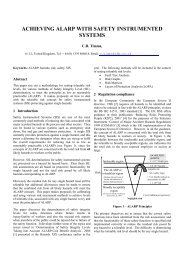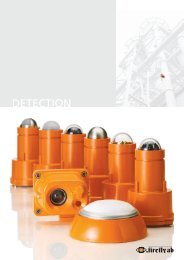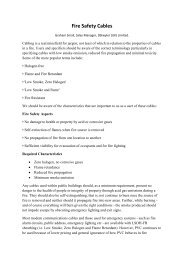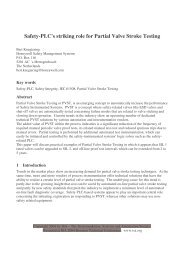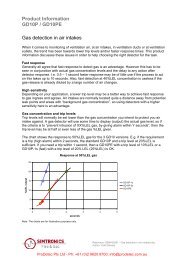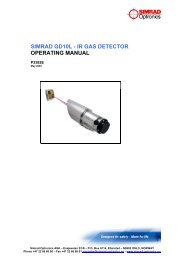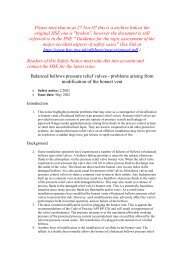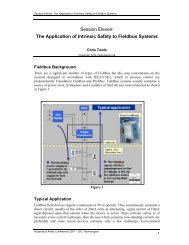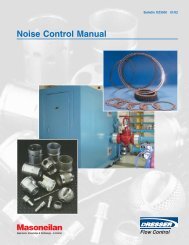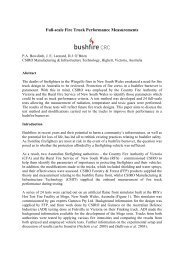The Tricon Turbine Control System - Invensys
The Tricon Turbine Control System - Invensys
The Tricon Turbine Control System - Invensys
- No tags were found...
You also want an ePaper? Increase the reach of your titles
YUMPU automatically turns print PDFs into web optimized ePapers that Google loves.
White Paper<strong>The</strong> <strong>Tricon</strong> <strong>Turbine</strong> <strong>Control</strong> <strong>System</strong>A Field-Proven Triple Modular Redundant (TMR) Digital <strong>System</strong>for <strong>Turbine</strong> <strong>Control</strong> and Safety Application in Nuclear Power PlantsAuthor: Naresh Desai, Sr. Technical Consultant, <strong>Invensys</strong>What’s Inside:1. Abstract2. Introduction3. Major Requirements4. <strong>Tricon</strong> Architecture5. Critical Application Software Architecture6. Operator Screens7. Summary
<strong>The</strong> <strong>Tricon</strong> <strong>Turbine</strong> <strong>Control</strong> <strong>System</strong>A Field-Proven Triple Modular Redundant (TMR) Digital <strong>System</strong>for <strong>Turbine</strong> <strong>Control</strong> and Safety Application in Nuclear Power Plants1. Abstract<strong>The</strong> <strong>Tricon</strong>ex® <strong>Tricon</strong> is a Triple Modular Redundant (TMR) digital system for turbinecontrol and safety application in nuclear power plants (NPPs). <strong>The</strong> steam turbine is a criticalelement in the continuous operation of NPPs. When a turbine goes offline, the entireplant goes down. Poor reliability of the existing obsolete control system is one of themajor causes of turbine trips. A single component failure can result in a turbine shutdown,causing unscheduled plant outages that cost hundreds of thousands of dollars per day inmaintenance costs and lost revenue. <strong>The</strong> <strong>Tricon</strong> is a high reliability and high availability(99.99%) turbine control system with no single point of failure. It provides an economicalsolution to the obsolescence, reliability and availability problems, while improving theoperational efficiency of NPPs.2. Introduction<strong>Turbine</strong> control systems are critical for the safe, efficient and continuous operation of anNPP. Existing control systems are old, obsolete, unreliable and hard to maintain due to<strong>Tricon</strong>ex <strong>Tricon</strong>the unavailability of spare parts. <strong>The</strong> staff at NPPs should not spend time trying to keepantiquated control systems running. <strong>The</strong> design and architecture of a critical control system should incorporate high reliability and highavailability as inherent attributes. This type of control system allows the plant operator to focus on the plant behavior, monitoring fieldparameters critical to maintaining the plant and quickly perform corrective actions when necessary.Aging turbine control systems must be replaced with high reliability and high availability, modern digital control systems, sounnecessary turbine trips and plant outages can be prevented. New turbine control systems must be easy to operate, maintain,upgrade and expand in the future.Nuclear power plants have various types of turbines from different vendors. Many turbines are reheat steam turbines that vary insize from a few hundred megawatts (MWs) to over 1000 MWs. Most monitoring, control and safety requirements are common to allturbines from different vendors. A turbine control system must have the capabilities and flexibility to handle common requirementsand vendor-specific requirements for all turbines.3. Major RequirementsReliability, Availability and Maintainability• High reliability and high availability with no single point of failure for continuous plant operation• Online diagnostics with more than 99.9% coverage• Online repair• Easy to maintain, modify and add future enhancements• Easy to upgrade and expand in the future without affecting existing field elements and wiringField Interface• Interface to the existing and new field elements for the turbine, if required.• Interface with other control systems throughout the plant<strong>Control</strong>, Safety and Test• Implement existing automatic or manual operational procedures and control strategies• Implement manual or automatic turbine chest and shell warm-up, turbine generator synchronization• Perform online valve tests (main control valves, main stop valves, reheat stop valves and intercept valves) and over speed detectiontest under operator control• Detect and safely shut down the system when unsafe plant conditions arise. Unsafe conditions include: turbine overspeed, loss oflube oil pressure, bearing temperature, vibration abnormalities, power load unbalance (PLU)• Automatic switching between speed control state (mode) to load control state, depending on the plant conditions• Droop control for speed and/or load stability• Automatic switching between full arc and partial arc (single valve mode and sequential valve mode) operationPage 1
<strong>The</strong> <strong>Tricon</strong> <strong>Turbine</strong> <strong>Control</strong> <strong>System</strong>A Field-Proven Triple Modular Redundant (TMR) Digital <strong>System</strong>for <strong>Turbine</strong> <strong>Control</strong> and Safety Application in Nuclear Power PlantsOperator Interface• Easy to use operator interface for monitoring and control• Enhanced visibility of critical turbine parameters in real-time• Easy navigation between the control, monitoring, maintenance and test screensCommunications• Ability to interface with existing plant computer and/or DCS system• Redundant, high-speed, industry standard communication interfaces and protocols to transfer real-time data (such as turbineparameters, field status, alarms, trips, system status, field inputs and outputs) for control, monitoring, logging and trending for fielddiagnostics purposes<strong>The</strong> <strong>Tricon</strong> satisfies the above requirements for turbine control in NPPs. <strong>The</strong> <strong>Tricon</strong> overall architecture is presented in Figure 1. Thisbasic architecture can be adapted to satisfy existing plant-specific field elements and wiring requirements, additional field elementrequirements, existing auto-manual turbine control procedures and strategies and communications requirements.4. <strong>Tricon</strong> ArchitectureA typical <strong>Tricon</strong> system consists of the following:• <strong>Tricon</strong> TMR system• TriStation 1131 application development station• <strong>Turbine</strong> control application software• I/A Series® or Wonderware® HMI (Human Machine Interface)• Maintenance workstation• TriLogger softwareA brief summary of the <strong>Tricon</strong> system components is provided below.<strong>Tricon</strong> <strong>System</strong><strong>The</strong> <strong>Tricon</strong> is a TMR architecture based digital safety and control system. <strong>The</strong> system is certified by TÜV (a world-recognized,independent safety agency) at International Electrotechnical Commission (IEC) Safety Integrity Level 3 (SIL) to be used for safety andcritical control applications in process control and other industries. <strong>The</strong> <strong>Tricon</strong> is also certified by the Nuclear Regulatory Commission(NRC) to be used for safety (1E) and critical control applications in NPPs.<strong>The</strong> <strong>Tricon</strong> has three independent channels from the input terminal to the output terminal. Each input is scanned and voted by thethree main processors (MPs) and the resultant voted input is provided to the same application running in the three MPs. <strong>The</strong> outputsfrom the application running in each MP go to the output modules where they are voted. <strong>The</strong> resultant voted output for each pointgoes to the output terminal/field device.<strong>The</strong> TMR architecture and design allows the <strong>Tricon</strong> system to perform its intended safety and control functions in the presence of asingle hardware fault. In addition, the design allows the <strong>Tricon</strong> to run in TMR, DUAL, or SINGLE mode, thus providing high availability(99.99%). <strong>The</strong> built-in online diagnostics provide more than 99.9% fault coverage and can isolate a fault to a specific module. <strong>The</strong>faulted module can be replaced with a new module online without affecting the turbine operation. <strong>The</strong> <strong>Tricon</strong> combines technologyand architecture features to provide safety and control functions with the high reliability and high availability required for the safetyand critical control applications NPPs.Page 2
<strong>The</strong> <strong>Tricon</strong> <strong>Turbine</strong> <strong>Control</strong> <strong>System</strong>A Field-Proven Triple Modular Redundant (TMR) Digital <strong>System</strong>for <strong>Turbine</strong> <strong>Control</strong> and Safety Application in Nuclear Power Plants6. Operator Screens<strong>The</strong> following standard turbine control and monitoring screens with security levels are available for both the I/A Series workstation andthe Wonderware workstation. <strong>The</strong>se standard screens can be modified and/or additional screens can be easily developed to meetnuclear plant operational requirements.• Main Menu Screen• <strong>Turbine</strong> Overview Screen• <strong>Turbine</strong> Start-up Screen• Normal Operation Screen• <strong>Turbine</strong> State (mode) Screen• Valve Tests Screen• Alarms and Trips• Maintenance and DiagnosticsPage 7
<strong>The</strong> <strong>Tricon</strong> <strong>Turbine</strong> <strong>Control</strong> <strong>System</strong>A Field-Proven Triple Modular Redundant (TMR) Digital <strong>System</strong>for <strong>Turbine</strong> <strong>Control</strong> and Safety Application in Nuclear Power Plants7. Summary<strong>Invensys</strong> is a customer-centric company that provides a complete solution to the nuclear industry for safety and critical control.<strong>Invensys</strong> has installed more than 1,500 turbine control systems in plants all over the world, including NPPs.<strong>The</strong> <strong>Tricon</strong> is a high reliability, high availability (99.99%), digital turbine control system with no single point of failure. <strong>The</strong> built-infeatures of the <strong>Tricon</strong> (high reliability, high availability, low maintenance, self-calibration, built-in online diagnostics, online repair, easyto expand and upgrade) help reduce life cycle operations and maintenance costs.<strong>The</strong> built-in online diagnostics provide more than 99.9% diagnostic coverage, providing a basis to potentially reduce periodicsurveillance testing between refueling cycles. Online repair increases availability even further, as turbines are not required to beshutdown to perform repairs.<strong>The</strong> <strong>Tricon</strong>ex <strong>Tricon</strong> solves the obsolescence, reliability and availability problems of NPPs, while improving the operational efficiency ofthe NPP.With a <strong>Tricon</strong> installation, you not only receive proven TMR technology, but the experience and knowledge of the <strong>Tricon</strong>ex turbinecontrol domain experts spanning over a quarter of a century in the industry. <strong>Tricon</strong>ex experts have seen and resolved many problemsassociated with the installation and operation of turbine control systems. If you experience problems with the installation or operation,it is highly probable that <strong>Tricon</strong>ex experts know about the problem and are ready to help you solve it. With <strong>Invensys</strong> you gainexperience in design, development, installation and support of the turbine control system, efficient project execution and integrationcapabilities, round-the- clock customer support and customized training for the I&C and plant operation personnel. <strong>The</strong> <strong>Tricon</strong> will bethe last system you will ever have to install for turbine control. Future expansions and upgrades can be completed in one or two days,not weeks. Existing cabinets, term panels, or field wiring do not need upgrading. This means you don’t have to perform continuitytests, loop checks, or recalibrations. <strong>The</strong> overall result is tremendous cost savings in expansion or upgrades, project managementefforts and reduced outage duration.<strong>Invensys</strong> Operations Management • 5601 Granite Parkway III, #1000, Plano, TX 75024 • Tel: (469) 365-6400 • Fax: (469) 365-6401 • iom.invensys.com<strong>Invensys</strong>, the <strong>Invensys</strong> logo, ArchestrA, Avantis, Eurotherm, Foxboro, IMServ, InFusion, SimSci-Esscor, Skelta, <strong>Tricon</strong>ex, and Wonderware are trademarks of <strong>Invensys</strong> plc, its subsidiaries or affiliates.All other brands and product names may be the trademarks or service marks of their representative owners.© 2010 <strong>Invensys</strong> <strong>System</strong>s, Inc. All rights reserved. No part of the material protected by this copyright may be reproduced or utilized in any form or by any means, electronic or mechanical, includingphotocopying, recording, broadcasting, or by any information storage and retrieval system, without permission in writing from <strong>Invensys</strong> <strong>System</strong>s, Inc.Rel. 10/10PN TR-0118Page 8



